Report: Principles and Practices of Assessment and Evaluation
VerifiedAdded on 2023/01/11
|24
|6719
|27
Report
AI Summary
This report delves into the core principles and practices of assessment, encompassing a wide range of topics essential for effective evaluation. It begins by defining key concepts such as validity, reliability, authenticity, and fairness, emphasizing their importance in ensuring a transparent and equitable assessment process. The report outlines crucial factors to consider when planning assessments, including standards, methods, resources, and learner needs. It highlights the benefits of a holistic approach, examining how it can address performance issues and provide a fair representation of learner abilities. The report further explores practical aspects, such as planning holistic assessments within specific skill areas and mitigating various risks associated with assessment, including health and safety, learner stress, and potential biases. It emphasizes the importance of involving learners and other stakeholders, promoting transparency and efficiency. Detailed explanations are provided regarding the information that should be made available to learners, the use of peer and self-assessment, and the adaptation of assessment arrangements to meet individual needs. The report also examines the mechanisms for judging evidence, ensuring assessment decisions, and the significance of standardization and quality assurance. It covers internal quality assurance procedures, appeal procedures, and the management of information related to assessment. Additionally, the report explores the role of feedback, questioning, legal issues, and the use of technology in assessment. It concludes by discussing best practices, reflective practice, and the maintenance of assessor expertise.
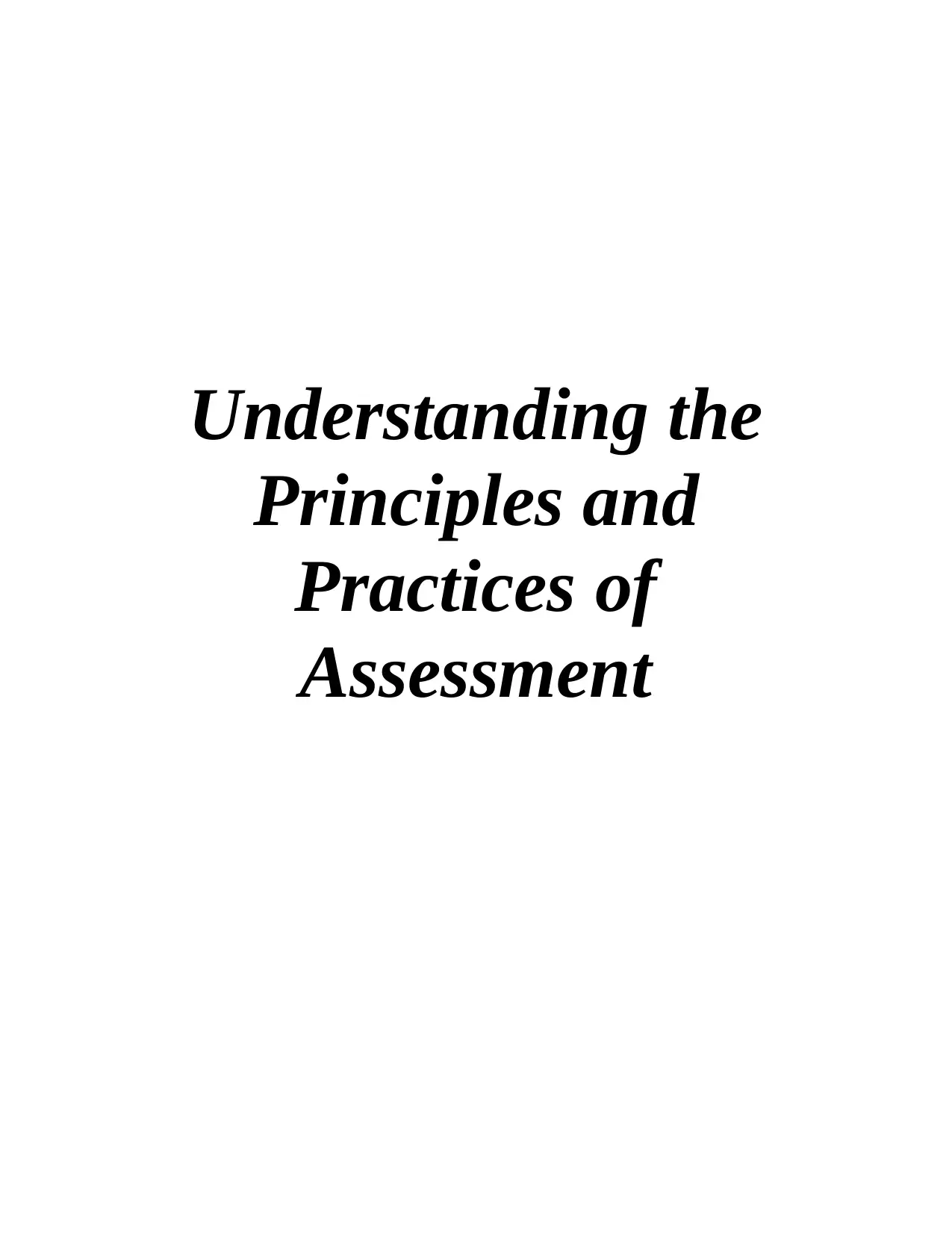
Understanding the
Principles and
Practices of
Assessment
Principles and
Practices of
Assessment
Paraphrase This Document
Need a fresh take? Get an instant paraphrase of this document with our AI Paraphraser
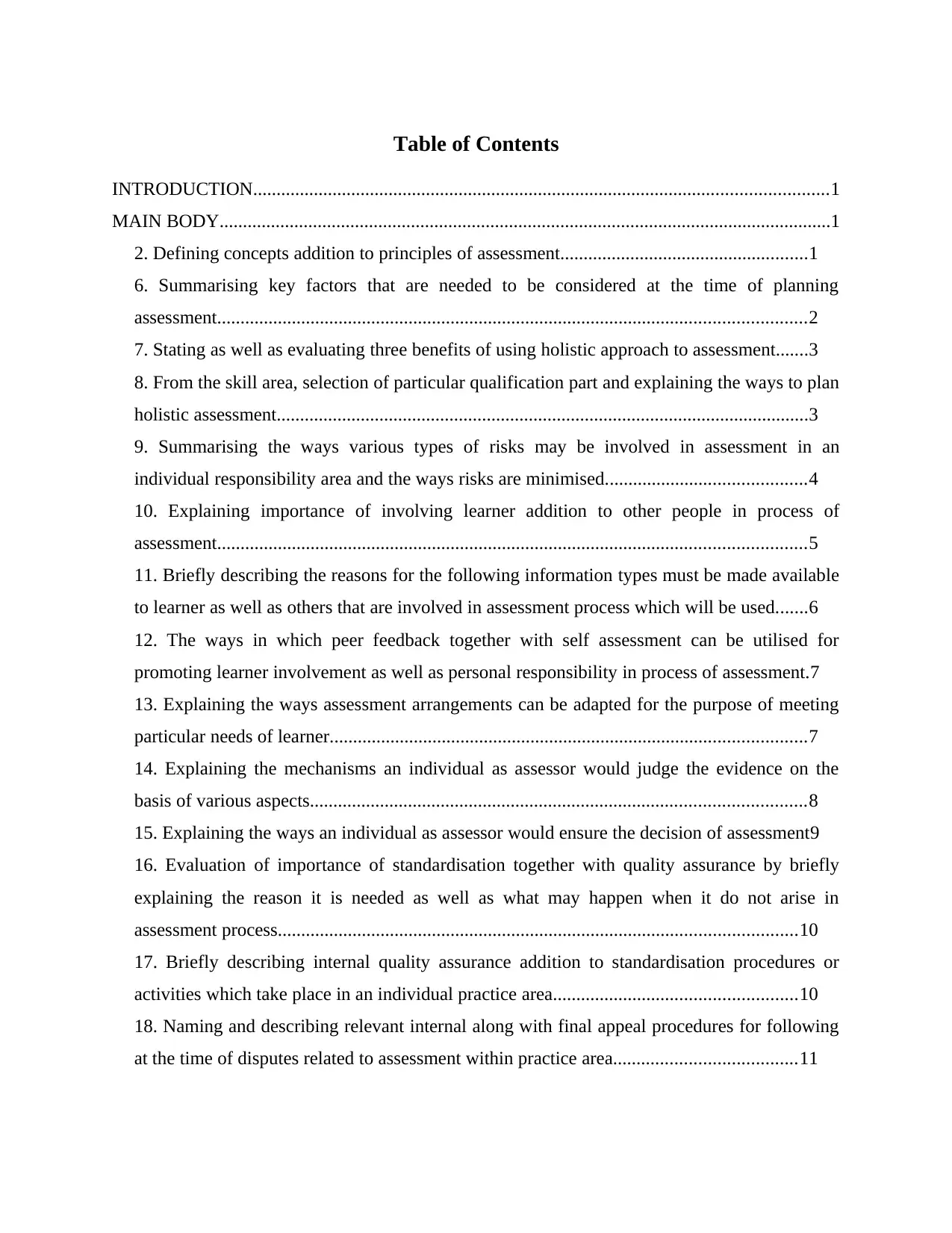
Table of Contents
INTRODUCTION...........................................................................................................................1
MAIN BODY...................................................................................................................................1
2. Defining concepts addition to principles of assessment.....................................................1
6. Summarising key factors that are needed to be considered at the time of planning
assessment..............................................................................................................................2
7. Stating as well as evaluating three benefits of using holistic approach to assessment.......3
8. From the skill area, selection of particular qualification part and explaining the ways to plan
holistic assessment..................................................................................................................3
9. Summarising the ways various types of risks may be involved in assessment in an
individual responsibility area and the ways risks are minimised...........................................4
10. Explaining importance of involving learner addition to other people in process of
assessment..............................................................................................................................5
11. Briefly describing the reasons for the following information types must be made available
to learner as well as others that are involved in assessment process which will be used.......6
12. The ways in which peer feedback together with self assessment can be utilised for
promoting learner involvement as well as personal responsibility in process of assessment.7
13. Explaining the ways assessment arrangements can be adapted for the purpose of meeting
particular needs of learner......................................................................................................7
14. Explaining the mechanisms an individual as assessor would judge the evidence on the
basis of various aspects..........................................................................................................8
15. Explaining the ways an individual as assessor would ensure the decision of assessment9
16. Evaluation of importance of standardisation together with quality assurance by briefly
explaining the reason it is needed as well as what may happen when it do not arise in
assessment process...............................................................................................................10
17. Briefly describing internal quality assurance addition to standardisation procedures or
activities which take place in an individual practice area....................................................10
18. Naming and describing relevant internal along with final appeal procedures for following
at the time of disputes related to assessment within practice area.......................................11
INTRODUCTION...........................................................................................................................1
MAIN BODY...................................................................................................................................1
2. Defining concepts addition to principles of assessment.....................................................1
6. Summarising key factors that are needed to be considered at the time of planning
assessment..............................................................................................................................2
7. Stating as well as evaluating three benefits of using holistic approach to assessment.......3
8. From the skill area, selection of particular qualification part and explaining the ways to plan
holistic assessment..................................................................................................................3
9. Summarising the ways various types of risks may be involved in assessment in an
individual responsibility area and the ways risks are minimised...........................................4
10. Explaining importance of involving learner addition to other people in process of
assessment..............................................................................................................................5
11. Briefly describing the reasons for the following information types must be made available
to learner as well as others that are involved in assessment process which will be used.......6
12. The ways in which peer feedback together with self assessment can be utilised for
promoting learner involvement as well as personal responsibility in process of assessment.7
13. Explaining the ways assessment arrangements can be adapted for the purpose of meeting
particular needs of learner......................................................................................................7
14. Explaining the mechanisms an individual as assessor would judge the evidence on the
basis of various aspects..........................................................................................................8
15. Explaining the ways an individual as assessor would ensure the decision of assessment9
16. Evaluation of importance of standardisation together with quality assurance by briefly
explaining the reason it is needed as well as what may happen when it do not arise in
assessment process...............................................................................................................10
17. Briefly describing internal quality assurance addition to standardisation procedures or
activities which take place in an individual practice area....................................................10
18. Naming and describing relevant internal along with final appeal procedures for following
at the time of disputes related to assessment within practice area.......................................11
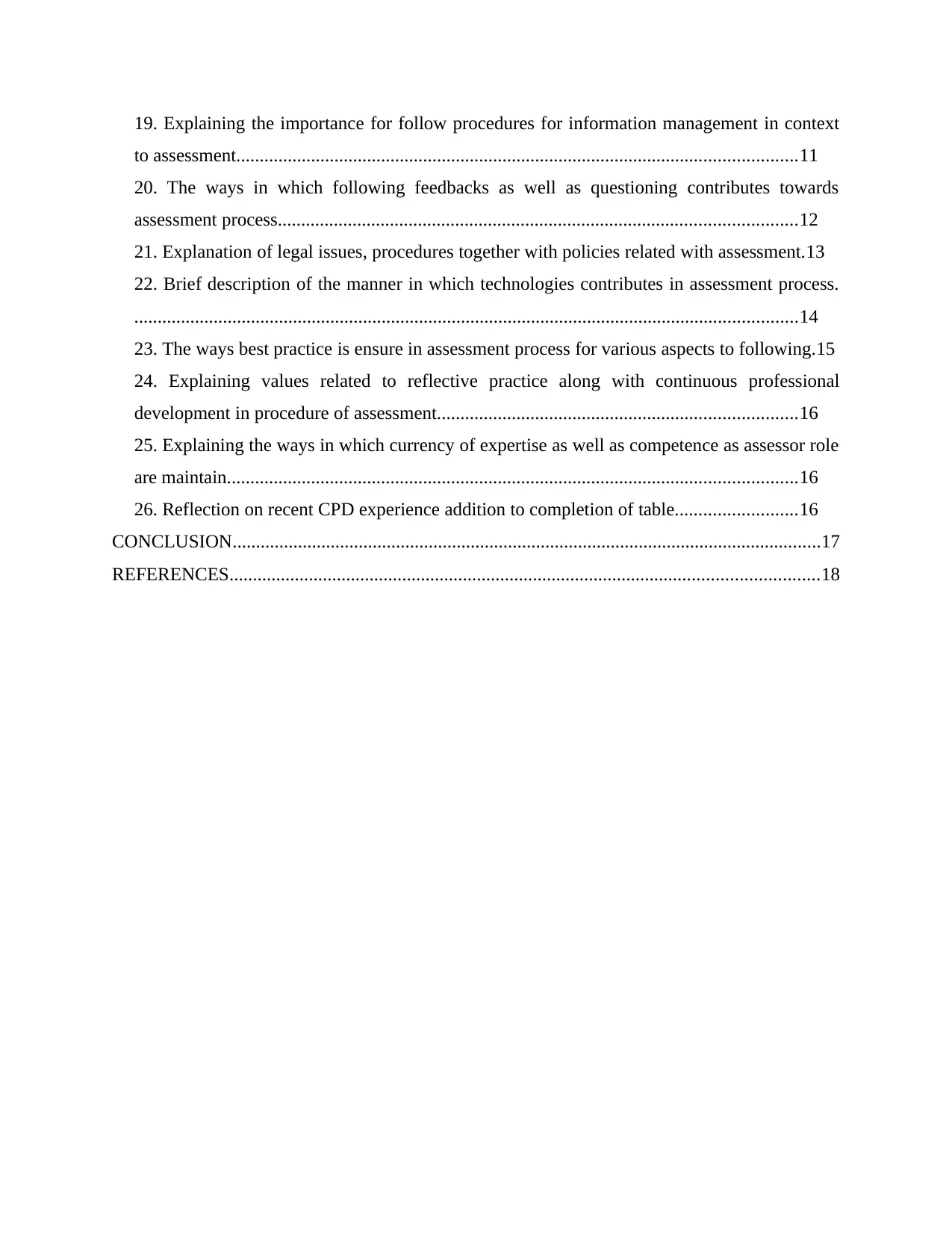
19. Explaining the importance for follow procedures for information management in context
to assessment........................................................................................................................11
20. The ways in which following feedbacks as well as questioning contributes towards
assessment process...............................................................................................................12
21. Explanation of legal issues, procedures together with policies related with assessment.13
22. Brief description of the manner in which technologies contributes in assessment process.
..............................................................................................................................................14
23. The ways best practice is ensure in assessment process for various aspects to following.15
24. Explaining values related to reflective practice along with continuous professional
development in procedure of assessment.............................................................................16
25. Explaining the ways in which currency of expertise as well as competence as assessor role
are maintain..........................................................................................................................16
26. Reflection on recent CPD experience addition to completion of table..........................16
CONCLUSION..............................................................................................................................17
REFERENCES..............................................................................................................................18
to assessment........................................................................................................................11
20. The ways in which following feedbacks as well as questioning contributes towards
assessment process...............................................................................................................12
21. Explanation of legal issues, procedures together with policies related with assessment.13
22. Brief description of the manner in which technologies contributes in assessment process.
..............................................................................................................................................14
23. The ways best practice is ensure in assessment process for various aspects to following.15
24. Explaining values related to reflective practice along with continuous professional
development in procedure of assessment.............................................................................16
25. Explaining the ways in which currency of expertise as well as competence as assessor role
are maintain..........................................................................................................................16
26. Reflection on recent CPD experience addition to completion of table..........................16
CONCLUSION..............................................................................................................................17
REFERENCES..............................................................................................................................18
⊘ This is a preview!⊘
Do you want full access?
Subscribe today to unlock all pages.

Trusted by 1+ million students worldwide
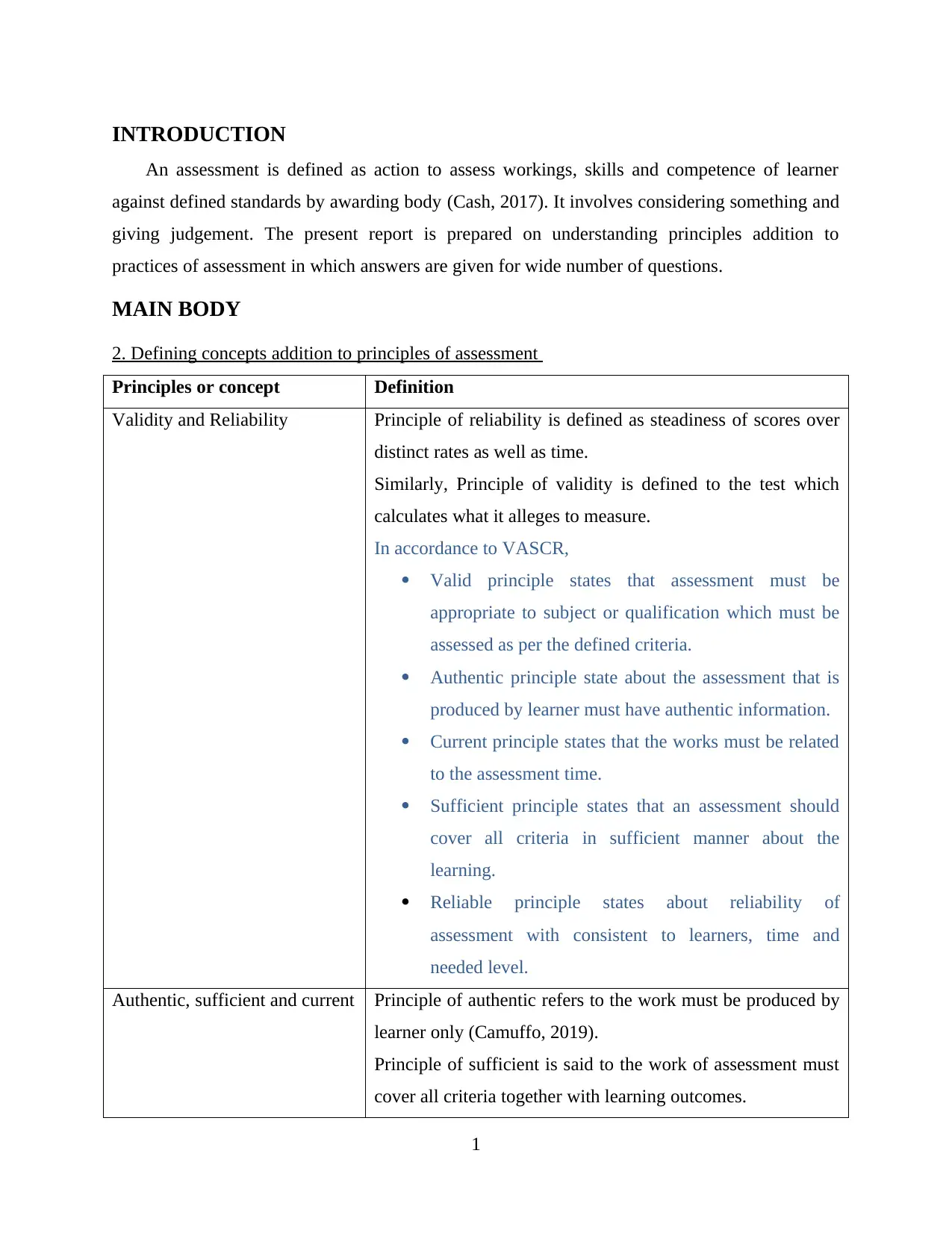
INTRODUCTION
An assessment is defined as action to assess workings, skills and competence of learner
against defined standards by awarding body (Cash, 2017). It involves considering something and
giving judgement. The present report is prepared on understanding principles addition to
practices of assessment in which answers are given for wide number of questions.
MAIN BODY
2. Defining concepts addition to principles of assessment
Principles or concept Definition
Validity and Reliability Principle of reliability is defined as steadiness of scores over
distinct rates as well as time.
Similarly, Principle of validity is defined to the test which
calculates what it alleges to measure.
In accordance to VASCR,
Valid principle states that assessment must be
appropriate to subject or qualification which must be
assessed as per the defined criteria.
Authentic principle state about the assessment that is
produced by learner must have authentic information.
Current principle states that the works must be related
to the assessment time.
Sufficient principle states that an assessment should
cover all criteria in sufficient manner about the
learning.
Reliable principle states about reliability of
assessment with consistent to learners, time and
needed level.
Authentic, sufficient and current Principle of authentic refers to the work must be produced by
learner only (Camuffo, 2019).
Principle of sufficient is said to the work of assessment must
cover all criteria together with learning outcomes.
1
An assessment is defined as action to assess workings, skills and competence of learner
against defined standards by awarding body (Cash, 2017). It involves considering something and
giving judgement. The present report is prepared on understanding principles addition to
practices of assessment in which answers are given for wide number of questions.
MAIN BODY
2. Defining concepts addition to principles of assessment
Principles or concept Definition
Validity and Reliability Principle of reliability is defined as steadiness of scores over
distinct rates as well as time.
Similarly, Principle of validity is defined to the test which
calculates what it alleges to measure.
In accordance to VASCR,
Valid principle states that assessment must be
appropriate to subject or qualification which must be
assessed as per the defined criteria.
Authentic principle state about the assessment that is
produced by learner must have authentic information.
Current principle states that the works must be related
to the assessment time.
Sufficient principle states that an assessment should
cover all criteria in sufficient manner about the
learning.
Reliable principle states about reliability of
assessment with consistent to learners, time and
needed level.
Authentic, sufficient and current Principle of authentic refers to the work must be produced by
learner only (Camuffo, 2019).
Principle of sufficient is said to the work of assessment must
cover all criteria together with learning outcomes.
1
Paraphrase This Document
Need a fresh take? Get an instant paraphrase of this document with our AI Paraphraser
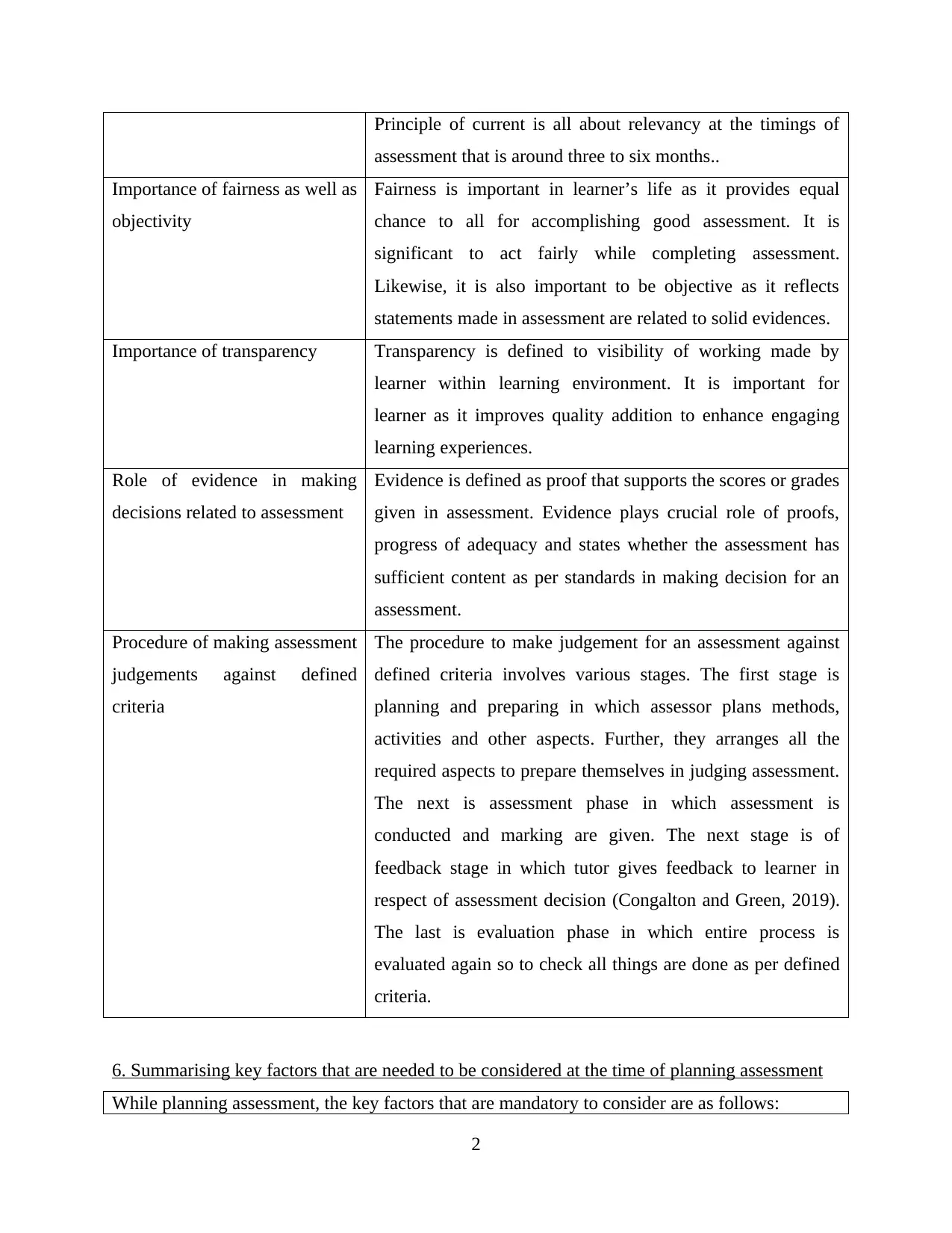
Principle of current is all about relevancy at the timings of
assessment that is around three to six months..
Importance of fairness as well as
objectivity
Fairness is important in learner’s life as it provides equal
chance to all for accomplishing good assessment. It is
significant to act fairly while completing assessment.
Likewise, it is also important to be objective as it reflects
statements made in assessment are related to solid evidences.
Importance of transparency Transparency is defined to visibility of working made by
learner within learning environment. It is important for
learner as it improves quality addition to enhance engaging
learning experiences.
Role of evidence in making
decisions related to assessment
Evidence is defined as proof that supports the scores or grades
given in assessment. Evidence plays crucial role of proofs,
progress of adequacy and states whether the assessment has
sufficient content as per standards in making decision for an
assessment.
Procedure of making assessment
judgements against defined
criteria
The procedure to make judgement for an assessment against
defined criteria involves various stages. The first stage is
planning and preparing in which assessor plans methods,
activities and other aspects. Further, they arranges all the
required aspects to prepare themselves in judging assessment.
The next is assessment phase in which assessment is
conducted and marking are given. The next stage is of
feedback stage in which tutor gives feedback to learner in
respect of assessment decision (Congalton and Green, 2019).
The last is evaluation phase in which entire process is
evaluated again so to check all things are done as per defined
criteria.
6. Summarising key factors that are needed to be considered at the time of planning assessment
While planning assessment, the key factors that are mandatory to consider are as follows:
2
assessment that is around three to six months..
Importance of fairness as well as
objectivity
Fairness is important in learner’s life as it provides equal
chance to all for accomplishing good assessment. It is
significant to act fairly while completing assessment.
Likewise, it is also important to be objective as it reflects
statements made in assessment are related to solid evidences.
Importance of transparency Transparency is defined to visibility of working made by
learner within learning environment. It is important for
learner as it improves quality addition to enhance engaging
learning experiences.
Role of evidence in making
decisions related to assessment
Evidence is defined as proof that supports the scores or grades
given in assessment. Evidence plays crucial role of proofs,
progress of adequacy and states whether the assessment has
sufficient content as per standards in making decision for an
assessment.
Procedure of making assessment
judgements against defined
criteria
The procedure to make judgement for an assessment against
defined criteria involves various stages. The first stage is
planning and preparing in which assessor plans methods,
activities and other aspects. Further, they arranges all the
required aspects to prepare themselves in judging assessment.
The next is assessment phase in which assessment is
conducted and marking are given. The next stage is of
feedback stage in which tutor gives feedback to learner in
respect of assessment decision (Congalton and Green, 2019).
The last is evaluation phase in which entire process is
evaluated again so to check all things are done as per defined
criteria.
6. Summarising key factors that are needed to be considered at the time of planning assessment
While planning assessment, the key factors that are mandatory to consider are as follows:
2
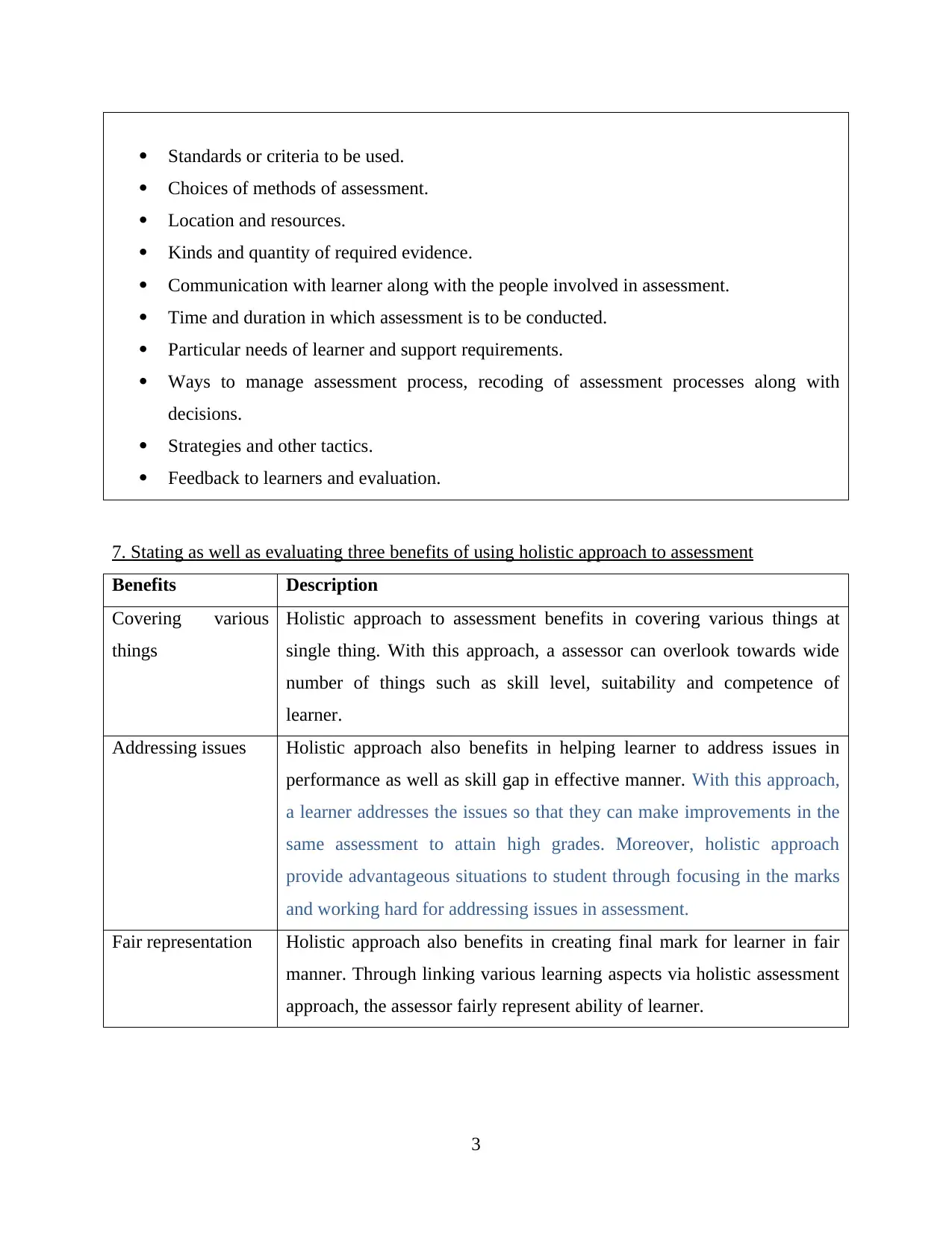
Standards or criteria to be used.
Choices of methods of assessment.
Location and resources.
Kinds and quantity of required evidence.
Communication with learner along with the people involved in assessment.
Time and duration in which assessment is to be conducted.
Particular needs of learner and support requirements.
Ways to manage assessment process, recoding of assessment processes along with
decisions.
Strategies and other tactics.
Feedback to learners and evaluation.
7. Stating as well as evaluating three benefits of using holistic approach to assessment
Benefits Description
Covering various
things
Holistic approach to assessment benefits in covering various things at
single thing. With this approach, a assessor can overlook towards wide
number of things such as skill level, suitability and competence of
learner.
Addressing issues Holistic approach also benefits in helping learner to address issues in
performance as well as skill gap in effective manner. With this approach,
a learner addresses the issues so that they can make improvements in the
same assessment to attain high grades. Moreover, holistic approach
provide advantageous situations to student through focusing in the marks
and working hard for addressing issues in assessment.
Fair representation Holistic approach also benefits in creating final mark for learner in fair
manner. Through linking various learning aspects via holistic assessment
approach, the assessor fairly represent ability of learner.
3
Choices of methods of assessment.
Location and resources.
Kinds and quantity of required evidence.
Communication with learner along with the people involved in assessment.
Time and duration in which assessment is to be conducted.
Particular needs of learner and support requirements.
Ways to manage assessment process, recoding of assessment processes along with
decisions.
Strategies and other tactics.
Feedback to learners and evaluation.
7. Stating as well as evaluating three benefits of using holistic approach to assessment
Benefits Description
Covering various
things
Holistic approach to assessment benefits in covering various things at
single thing. With this approach, a assessor can overlook towards wide
number of things such as skill level, suitability and competence of
learner.
Addressing issues Holistic approach also benefits in helping learner to address issues in
performance as well as skill gap in effective manner. With this approach,
a learner addresses the issues so that they can make improvements in the
same assessment to attain high grades. Moreover, holistic approach
provide advantageous situations to student through focusing in the marks
and working hard for addressing issues in assessment.
Fair representation Holistic approach also benefits in creating final mark for learner in fair
manner. Through linking various learning aspects via holistic assessment
approach, the assessor fairly represent ability of learner.
3
⊘ This is a preview!⊘
Do you want full access?
Subscribe today to unlock all pages.

Trusted by 1+ million students worldwide
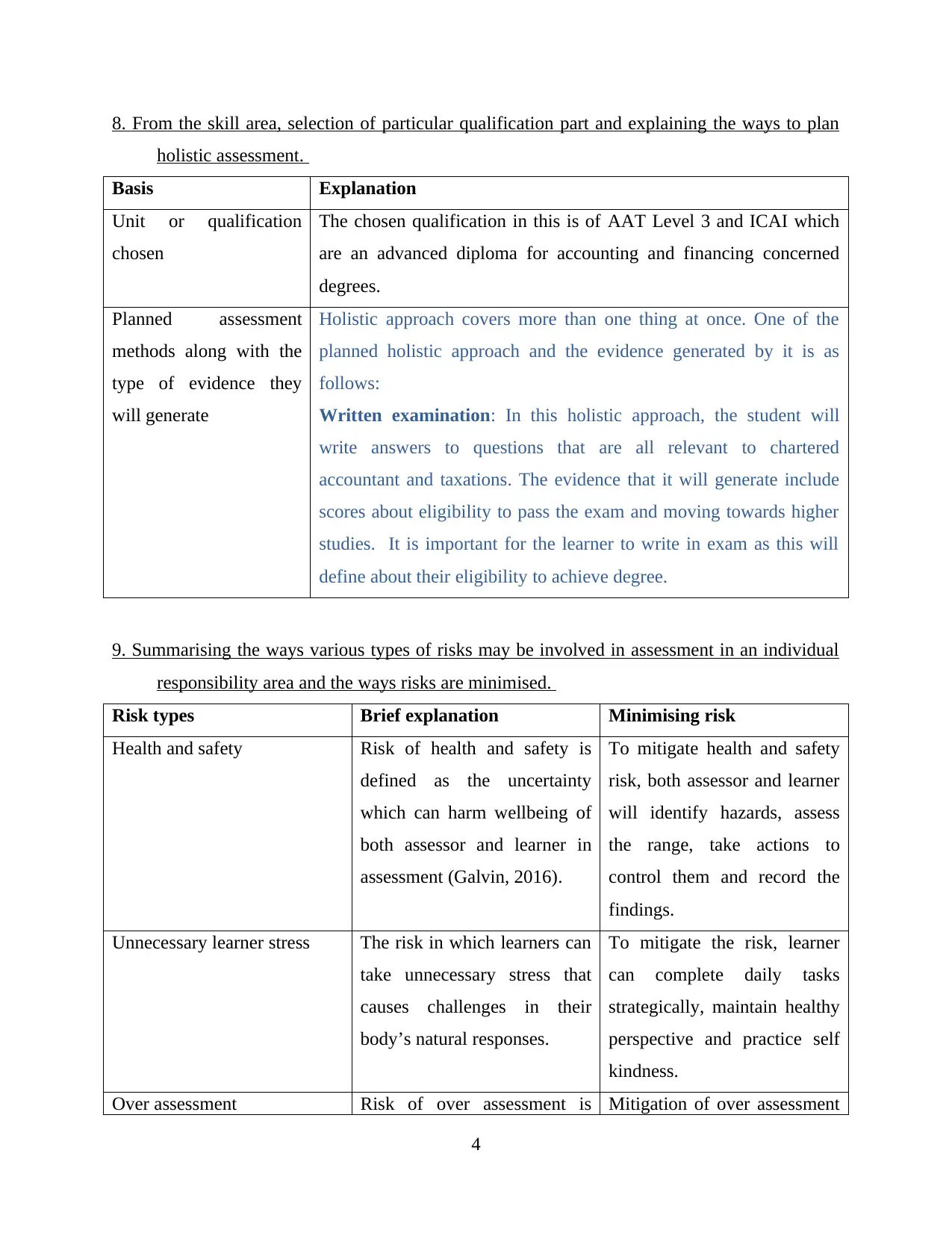
8. From the skill area, selection of particular qualification part and explaining the ways to plan
holistic assessment.
Basis Explanation
Unit or qualification
chosen
The chosen qualification in this is of AAT Level 3 and ICAI which
are an advanced diploma for accounting and financing concerned
degrees.
Planned assessment
methods along with the
type of evidence they
will generate
Holistic approach covers more than one thing at once. One of the
planned holistic approach and the evidence generated by it is as
follows:
Written examination: In this holistic approach, the student will
write answers to questions that are all relevant to chartered
accountant and taxations. The evidence that it will generate include
scores about eligibility to pass the exam and moving towards higher
studies. It is important for the learner to write in exam as this will
define about their eligibility to achieve degree.
9. Summarising the ways various types of risks may be involved in assessment in an individual
responsibility area and the ways risks are minimised.
Risk types Brief explanation Minimising risk
Health and safety Risk of health and safety is
defined as the uncertainty
which can harm wellbeing of
both assessor and learner in
assessment (Galvin, 2016).
To mitigate health and safety
risk, both assessor and learner
will identify hazards, assess
the range, take actions to
control them and record the
findings.
Unnecessary learner stress The risk in which learners can
take unnecessary stress that
causes challenges in their
body’s natural responses.
To mitigate the risk, learner
can complete daily tasks
strategically, maintain healthy
perspective and practice self
kindness.
Over assessment Risk of over assessment is Mitigation of over assessment
4
holistic assessment.
Basis Explanation
Unit or qualification
chosen
The chosen qualification in this is of AAT Level 3 and ICAI which
are an advanced diploma for accounting and financing concerned
degrees.
Planned assessment
methods along with the
type of evidence they
will generate
Holistic approach covers more than one thing at once. One of the
planned holistic approach and the evidence generated by it is as
follows:
Written examination: In this holistic approach, the student will
write answers to questions that are all relevant to chartered
accountant and taxations. The evidence that it will generate include
scores about eligibility to pass the exam and moving towards higher
studies. It is important for the learner to write in exam as this will
define about their eligibility to achieve degree.
9. Summarising the ways various types of risks may be involved in assessment in an individual
responsibility area and the ways risks are minimised.
Risk types Brief explanation Minimising risk
Health and safety Risk of health and safety is
defined as the uncertainty
which can harm wellbeing of
both assessor and learner in
assessment (Galvin, 2016).
To mitigate health and safety
risk, both assessor and learner
will identify hazards, assess
the range, take actions to
control them and record the
findings.
Unnecessary learner stress The risk in which learners can
take unnecessary stress that
causes challenges in their
body’s natural responses.
To mitigate the risk, learner
can complete daily tasks
strategically, maintain healthy
perspective and practice self
kindness.
Over assessment Risk of over assessment is Mitigation of over assessment
4
Paraphrase This Document
Need a fresh take? Get an instant paraphrase of this document with our AI Paraphraser
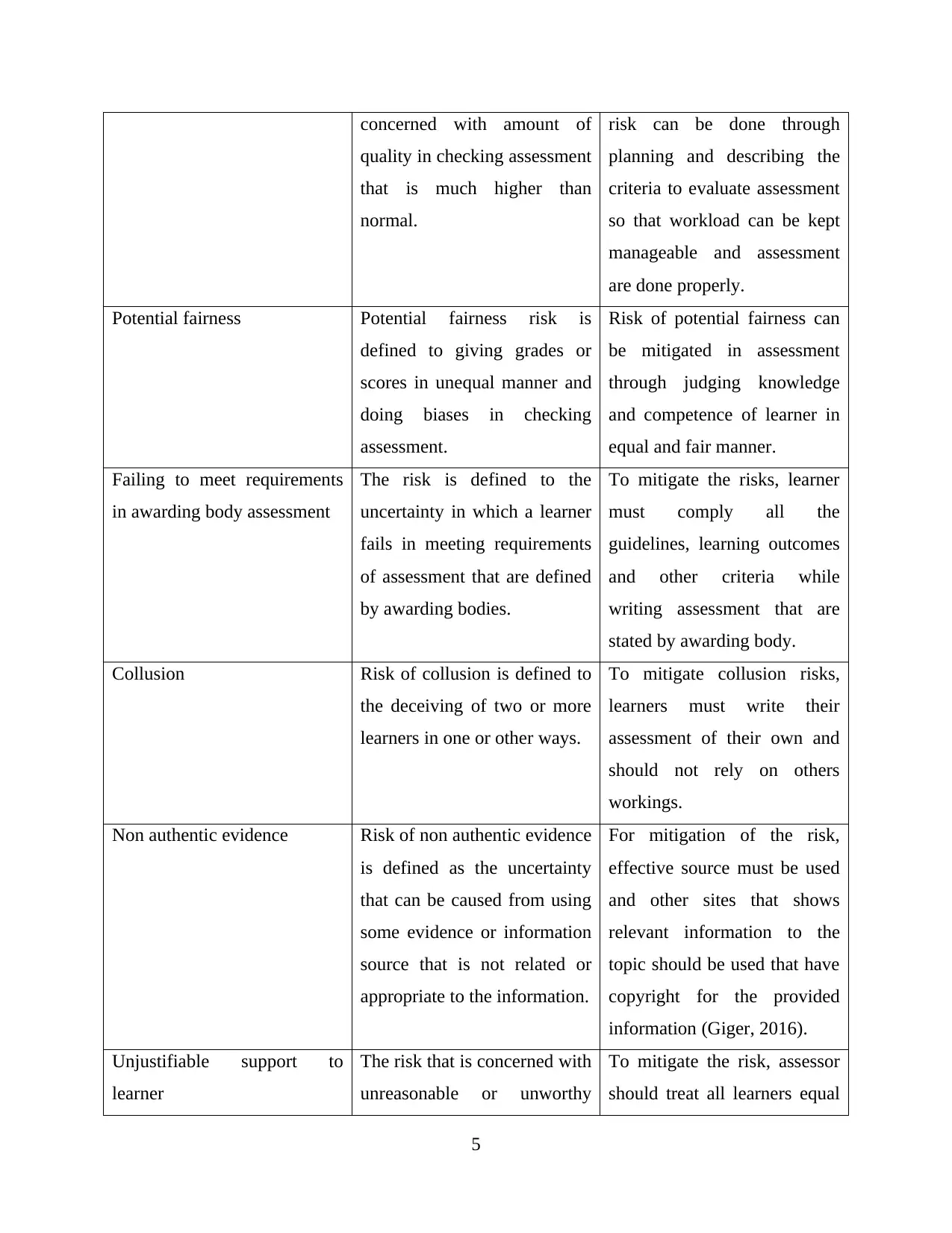
concerned with amount of
quality in checking assessment
that is much higher than
normal.
risk can be done through
planning and describing the
criteria to evaluate assessment
so that workload can be kept
manageable and assessment
are done properly.
Potential fairness Potential fairness risk is
defined to giving grades or
scores in unequal manner and
doing biases in checking
assessment.
Risk of potential fairness can
be mitigated in assessment
through judging knowledge
and competence of learner in
equal and fair manner.
Failing to meet requirements
in awarding body assessment
The risk is defined to the
uncertainty in which a learner
fails in meeting requirements
of assessment that are defined
by awarding bodies.
To mitigate the risks, learner
must comply all the
guidelines, learning outcomes
and other criteria while
writing assessment that are
stated by awarding body.
Collusion Risk of collusion is defined to
the deceiving of two or more
learners in one or other ways.
To mitigate collusion risks,
learners must write their
assessment of their own and
should not rely on others
workings.
Non authentic evidence Risk of non authentic evidence
is defined as the uncertainty
that can be caused from using
some evidence or information
source that is not related or
appropriate to the information.
For mitigation of the risk,
effective source must be used
and other sites that shows
relevant information to the
topic should be used that have
copyright for the provided
information (Giger, 2016).
Unjustifiable support to
learner
The risk that is concerned with
unreasonable or unworthy
To mitigate the risk, assessor
should treat all learners equal
5
quality in checking assessment
that is much higher than
normal.
risk can be done through
planning and describing the
criteria to evaluate assessment
so that workload can be kept
manageable and assessment
are done properly.
Potential fairness Potential fairness risk is
defined to giving grades or
scores in unequal manner and
doing biases in checking
assessment.
Risk of potential fairness can
be mitigated in assessment
through judging knowledge
and competence of learner in
equal and fair manner.
Failing to meet requirements
in awarding body assessment
The risk is defined to the
uncertainty in which a learner
fails in meeting requirements
of assessment that are defined
by awarding bodies.
To mitigate the risks, learner
must comply all the
guidelines, learning outcomes
and other criteria while
writing assessment that are
stated by awarding body.
Collusion Risk of collusion is defined to
the deceiving of two or more
learners in one or other ways.
To mitigate collusion risks,
learners must write their
assessment of their own and
should not rely on others
workings.
Non authentic evidence Risk of non authentic evidence
is defined as the uncertainty
that can be caused from using
some evidence or information
source that is not related or
appropriate to the information.
For mitigation of the risk,
effective source must be used
and other sites that shows
relevant information to the
topic should be used that have
copyright for the provided
information (Giger, 2016).
Unjustifiable support to
learner
The risk that is concerned with
unreasonable or unworthy
To mitigate the risk, assessor
should treat all learners equal
5
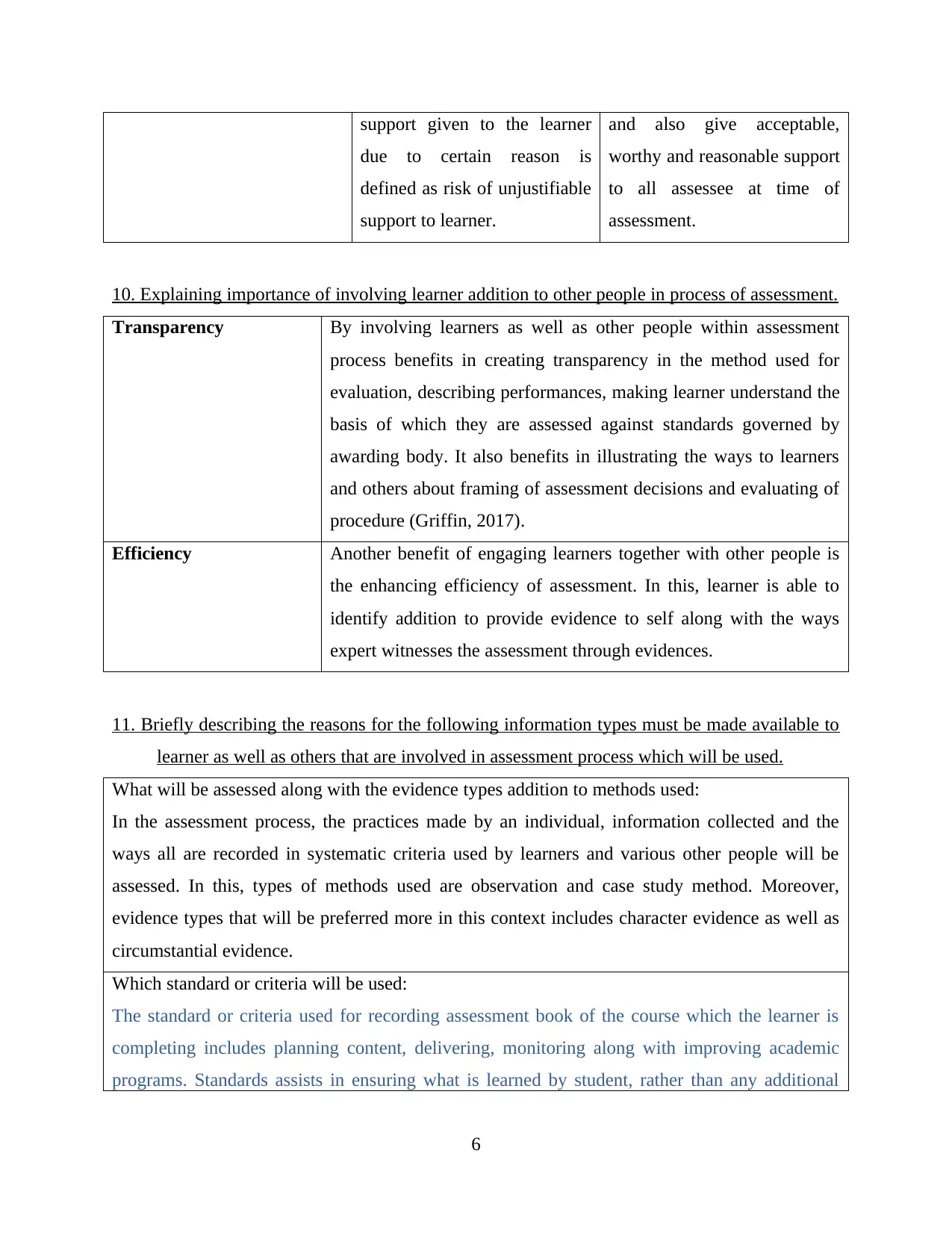
support given to the learner
due to certain reason is
defined as risk of unjustifiable
support to learner.
and also give acceptable,
worthy and reasonable support
to all assessee at time of
assessment.
10. Explaining importance of involving learner addition to other people in process of assessment.
Transparency By involving learners as well as other people within assessment
process benefits in creating transparency in the method used for
evaluation, describing performances, making learner understand the
basis of which they are assessed against standards governed by
awarding body. It also benefits in illustrating the ways to learners
and others about framing of assessment decisions and evaluating of
procedure (Griffin, 2017).
Efficiency Another benefit of engaging learners together with other people is
the enhancing efficiency of assessment. In this, learner is able to
identify addition to provide evidence to self along with the ways
expert witnesses the assessment through evidences.
11. Briefly describing the reasons for the following information types must be made available to
learner as well as others that are involved in assessment process which will be used.
What will be assessed along with the evidence types addition to methods used:
In the assessment process, the practices made by an individual, information collected and the
ways all are recorded in systematic criteria used by learners and various other people will be
assessed. In this, types of methods used are observation and case study method. Moreover,
evidence types that will be preferred more in this context includes character evidence as well as
circumstantial evidence.
Which standard or criteria will be used:
The standard or criteria used for recording assessment book of the course which the learner is
completing includes planning content, delivering, monitoring along with improving academic
programs. Standards assists in ensuring what is learned by student, rather than any additional
6
due to certain reason is
defined as risk of unjustifiable
support to learner.
and also give acceptable,
worthy and reasonable support
to all assessee at time of
assessment.
10. Explaining importance of involving learner addition to other people in process of assessment.
Transparency By involving learners as well as other people within assessment
process benefits in creating transparency in the method used for
evaluation, describing performances, making learner understand the
basis of which they are assessed against standards governed by
awarding body. It also benefits in illustrating the ways to learners
and others about framing of assessment decisions and evaluating of
procedure (Griffin, 2017).
Efficiency Another benefit of engaging learners together with other people is
the enhancing efficiency of assessment. In this, learner is able to
identify addition to provide evidence to self along with the ways
expert witnesses the assessment through evidences.
11. Briefly describing the reasons for the following information types must be made available to
learner as well as others that are involved in assessment process which will be used.
What will be assessed along with the evidence types addition to methods used:
In the assessment process, the practices made by an individual, information collected and the
ways all are recorded in systematic criteria used by learners and various other people will be
assessed. In this, types of methods used are observation and case study method. Moreover,
evidence types that will be preferred more in this context includes character evidence as well as
circumstantial evidence.
Which standard or criteria will be used:
The standard or criteria used for recording assessment book of the course which the learner is
completing includes planning content, delivering, monitoring along with improving academic
programs. Standards assists in ensuring what is learned by student, rather than any additional
6
⊘ This is a preview!⊘
Do you want full access?
Subscribe today to unlock all pages.

Trusted by 1+ million students worldwide
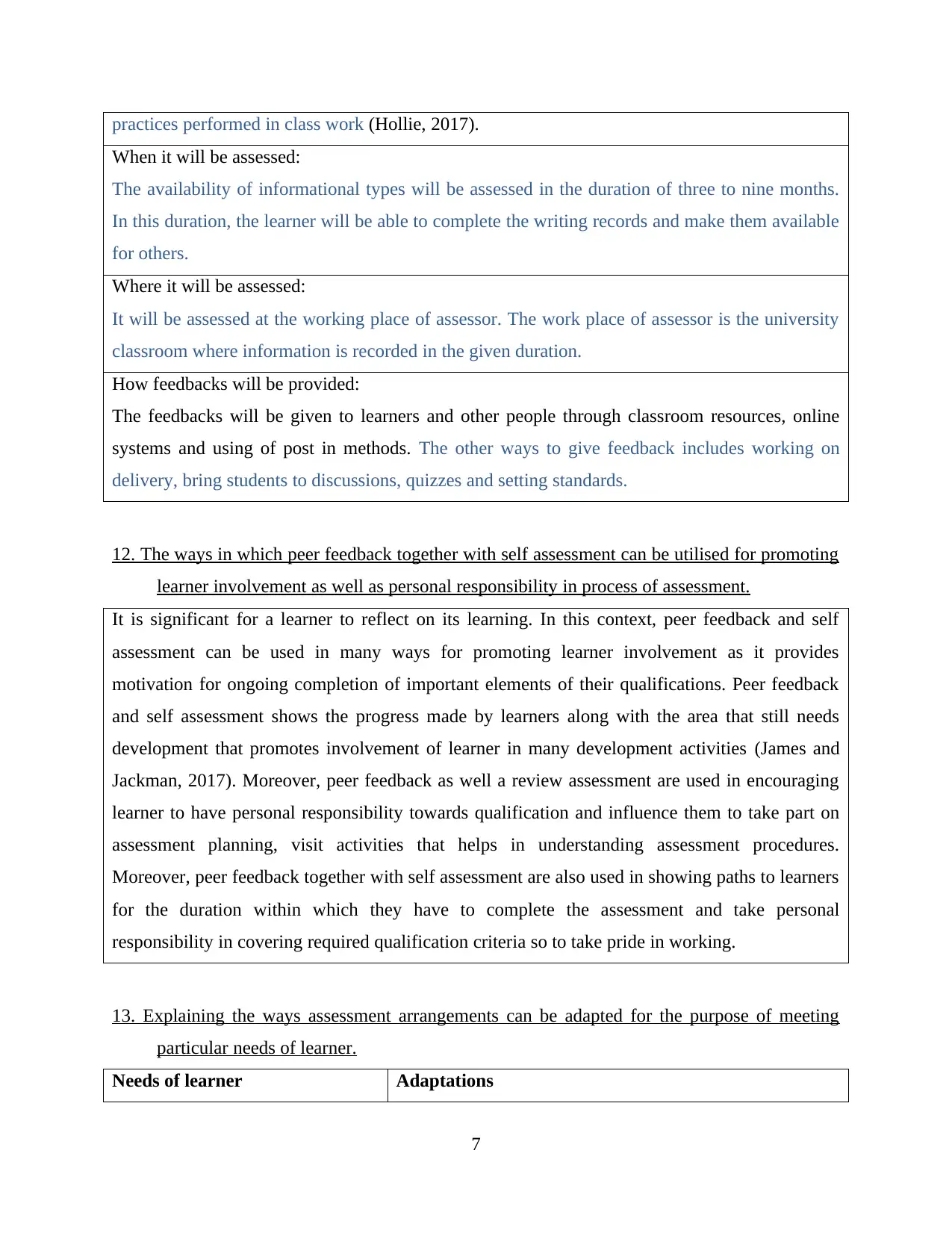
practices performed in class work (Hollie, 2017).
When it will be assessed:
The availability of informational types will be assessed in the duration of three to nine months.
In this duration, the learner will be able to complete the writing records and make them available
for others.
Where it will be assessed:
It will be assessed at the working place of assessor. The work place of assessor is the university
classroom where information is recorded in the given duration.
How feedbacks will be provided:
The feedbacks will be given to learners and other people through classroom resources, online
systems and using of post in methods. The other ways to give feedback includes working on
delivery, bring students to discussions, quizzes and setting standards.
12. The ways in which peer feedback together with self assessment can be utilised for promoting
learner involvement as well as personal responsibility in process of assessment.
It is significant for a learner to reflect on its learning. In this context, peer feedback and self
assessment can be used in many ways for promoting learner involvement as it provides
motivation for ongoing completion of important elements of their qualifications. Peer feedback
and self assessment shows the progress made by learners along with the area that still needs
development that promotes involvement of learner in many development activities (James and
Jackman, 2017). Moreover, peer feedback as well a review assessment are used in encouraging
learner to have personal responsibility towards qualification and influence them to take part on
assessment planning, visit activities that helps in understanding assessment procedures.
Moreover, peer feedback together with self assessment are also used in showing paths to learners
for the duration within which they have to complete the assessment and take personal
responsibility in covering required qualification criteria so to take pride in working.
13. Explaining the ways assessment arrangements can be adapted for the purpose of meeting
particular needs of learner.
Needs of learner Adaptations
7
When it will be assessed:
The availability of informational types will be assessed in the duration of three to nine months.
In this duration, the learner will be able to complete the writing records and make them available
for others.
Where it will be assessed:
It will be assessed at the working place of assessor. The work place of assessor is the university
classroom where information is recorded in the given duration.
How feedbacks will be provided:
The feedbacks will be given to learners and other people through classroom resources, online
systems and using of post in methods. The other ways to give feedback includes working on
delivery, bring students to discussions, quizzes and setting standards.
12. The ways in which peer feedback together with self assessment can be utilised for promoting
learner involvement as well as personal responsibility in process of assessment.
It is significant for a learner to reflect on its learning. In this context, peer feedback and self
assessment can be used in many ways for promoting learner involvement as it provides
motivation for ongoing completion of important elements of their qualifications. Peer feedback
and self assessment shows the progress made by learners along with the area that still needs
development that promotes involvement of learner in many development activities (James and
Jackman, 2017). Moreover, peer feedback as well a review assessment are used in encouraging
learner to have personal responsibility towards qualification and influence them to take part on
assessment planning, visit activities that helps in understanding assessment procedures.
Moreover, peer feedback together with self assessment are also used in showing paths to learners
for the duration within which they have to complete the assessment and take personal
responsibility in covering required qualification criteria so to take pride in working.
13. Explaining the ways assessment arrangements can be adapted for the purpose of meeting
particular needs of learner.
Needs of learner Adaptations
7
Paraphrase This Document
Need a fresh take? Get an instant paraphrase of this document with our AI Paraphraser
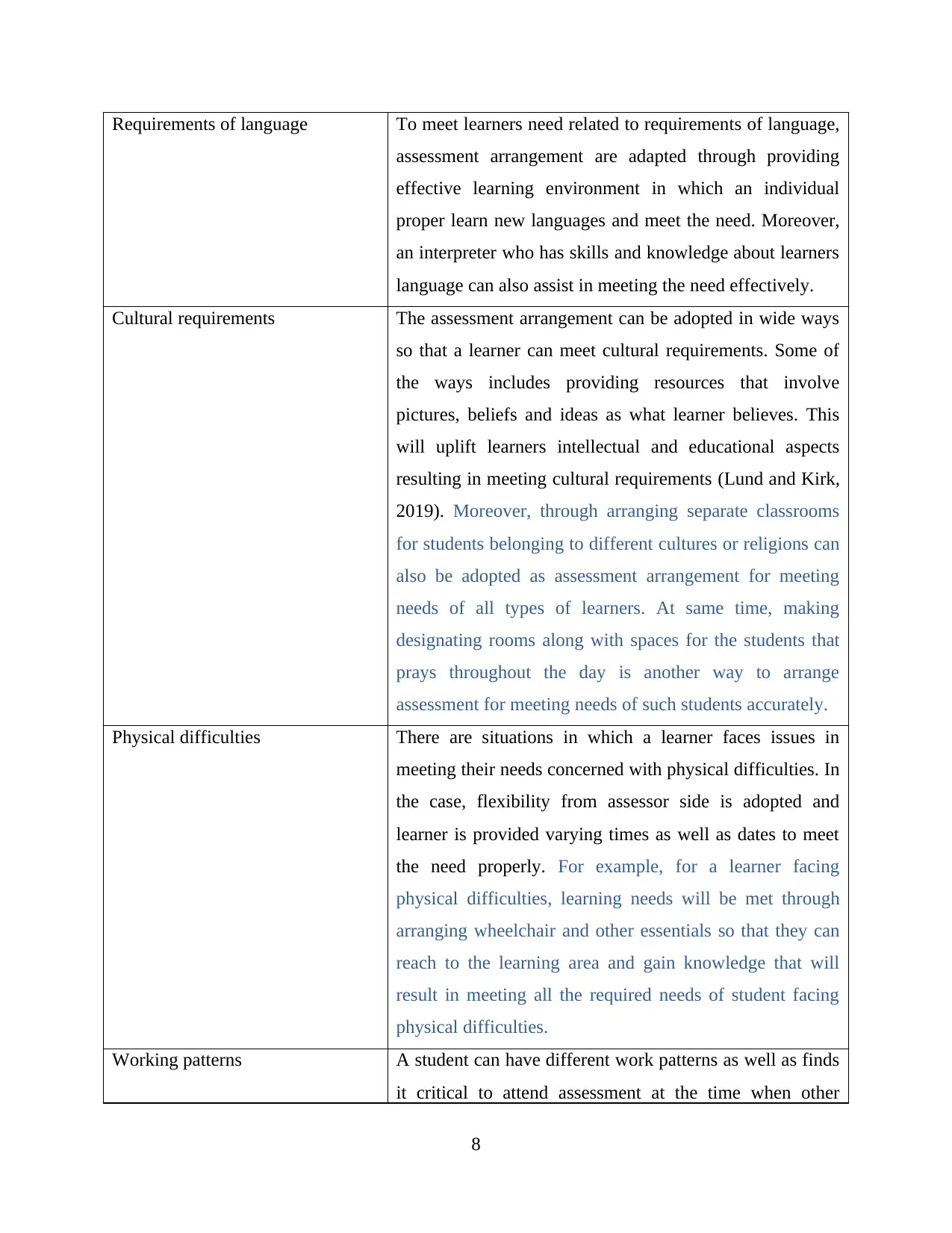
Requirements of language To meet learners need related to requirements of language,
assessment arrangement are adapted through providing
effective learning environment in which an individual
proper learn new languages and meet the need. Moreover,
an interpreter who has skills and knowledge about learners
language can also assist in meeting the need effectively.
Cultural requirements The assessment arrangement can be adopted in wide ways
so that a learner can meet cultural requirements. Some of
the ways includes providing resources that involve
pictures, beliefs and ideas as what learner believes. This
will uplift learners intellectual and educational aspects
resulting in meeting cultural requirements (Lund and Kirk,
2019). Moreover, through arranging separate classrooms
for students belonging to different cultures or religions can
also be adopted as assessment arrangement for meeting
needs of all types of learners. At same time, making
designating rooms along with spaces for the students that
prays throughout the day is another way to arrange
assessment for meeting needs of such students accurately.
Physical difficulties There are situations in which a learner faces issues in
meeting their needs concerned with physical difficulties. In
the case, flexibility from assessor side is adopted and
learner is provided varying times as well as dates to meet
the need properly. For example, for a learner facing
physical difficulties, learning needs will be met through
arranging wheelchair and other essentials so that they can
reach to the learning area and gain knowledge that will
result in meeting all the required needs of student facing
physical difficulties.
Working patterns A student can have different work patterns as well as finds
it critical to attend assessment at the time when other
8
assessment arrangement are adapted through providing
effective learning environment in which an individual
proper learn new languages and meet the need. Moreover,
an interpreter who has skills and knowledge about learners
language can also assist in meeting the need effectively.
Cultural requirements The assessment arrangement can be adopted in wide ways
so that a learner can meet cultural requirements. Some of
the ways includes providing resources that involve
pictures, beliefs and ideas as what learner believes. This
will uplift learners intellectual and educational aspects
resulting in meeting cultural requirements (Lund and Kirk,
2019). Moreover, through arranging separate classrooms
for students belonging to different cultures or religions can
also be adopted as assessment arrangement for meeting
needs of all types of learners. At same time, making
designating rooms along with spaces for the students that
prays throughout the day is another way to arrange
assessment for meeting needs of such students accurately.
Physical difficulties There are situations in which a learner faces issues in
meeting their needs concerned with physical difficulties. In
the case, flexibility from assessor side is adopted and
learner is provided varying times as well as dates to meet
the need properly. For example, for a learner facing
physical difficulties, learning needs will be met through
arranging wheelchair and other essentials so that they can
reach to the learning area and gain knowledge that will
result in meeting all the required needs of student facing
physical difficulties.
Working patterns A student can have different work patterns as well as finds
it critical to attend assessment at the time when other
8
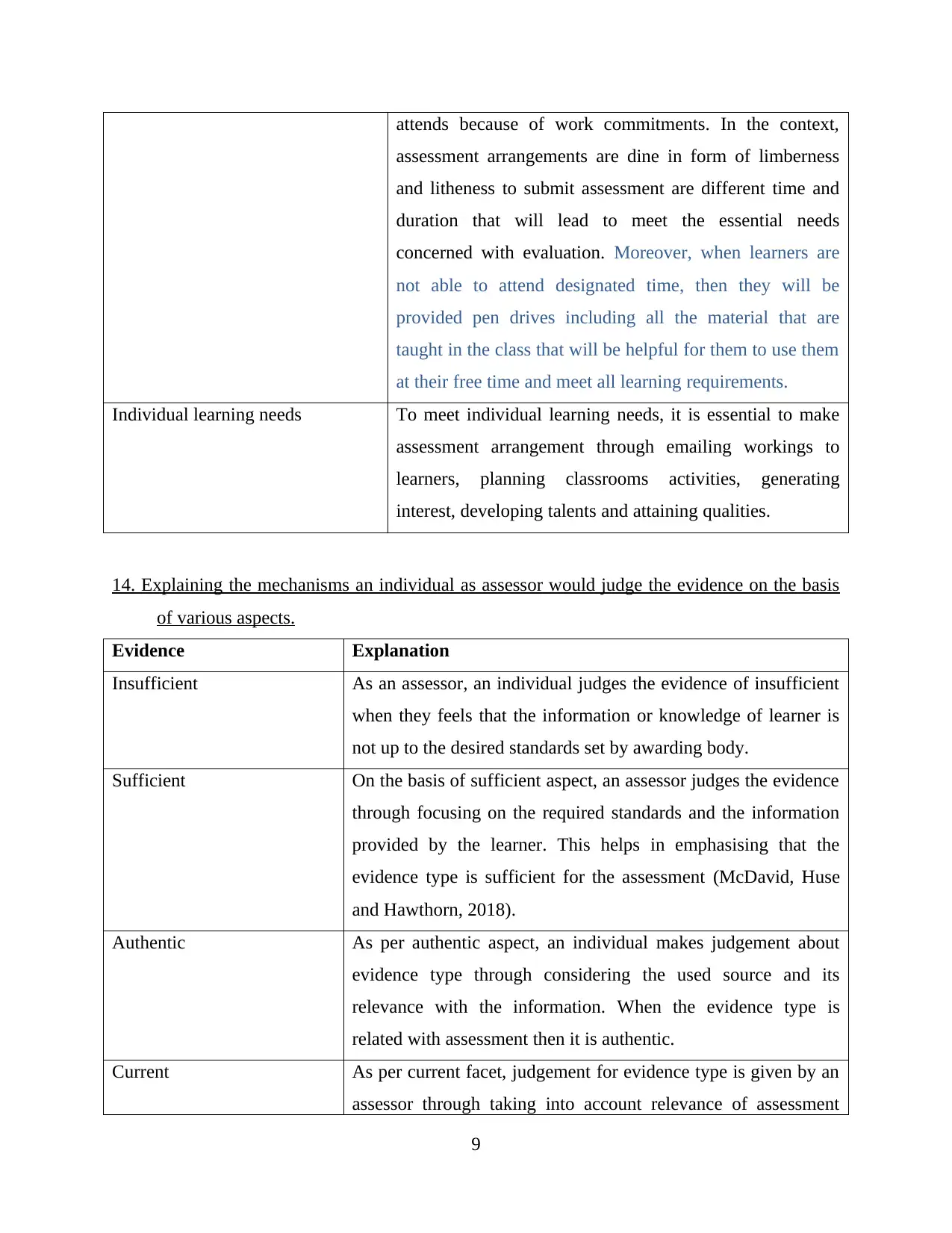
attends because of work commitments. In the context,
assessment arrangements are dine in form of limberness
and litheness to submit assessment are different time and
duration that will lead to meet the essential needs
concerned with evaluation. Moreover, when learners are
not able to attend designated time, then they will be
provided pen drives including all the material that are
taught in the class that will be helpful for them to use them
at their free time and meet all learning requirements.
Individual learning needs To meet individual learning needs, it is essential to make
assessment arrangement through emailing workings to
learners, planning classrooms activities, generating
interest, developing talents and attaining qualities.
14. Explaining the mechanisms an individual as assessor would judge the evidence on the basis
of various aspects.
Evidence Explanation
Insufficient As an assessor, an individual judges the evidence of insufficient
when they feels that the information or knowledge of learner is
not up to the desired standards set by awarding body.
Sufficient On the basis of sufficient aspect, an assessor judges the evidence
through focusing on the required standards and the information
provided by the learner. This helps in emphasising that the
evidence type is sufficient for the assessment (McDavid, Huse
and Hawthorn, 2018).
Authentic As per authentic aspect, an individual makes judgement about
evidence type through considering the used source and its
relevance with the information. When the evidence type is
related with assessment then it is authentic.
Current As per current facet, judgement for evidence type is given by an
assessor through taking into account relevance of assessment
9
assessment arrangements are dine in form of limberness
and litheness to submit assessment are different time and
duration that will lead to meet the essential needs
concerned with evaluation. Moreover, when learners are
not able to attend designated time, then they will be
provided pen drives including all the material that are
taught in the class that will be helpful for them to use them
at their free time and meet all learning requirements.
Individual learning needs To meet individual learning needs, it is essential to make
assessment arrangement through emailing workings to
learners, planning classrooms activities, generating
interest, developing talents and attaining qualities.
14. Explaining the mechanisms an individual as assessor would judge the evidence on the basis
of various aspects.
Evidence Explanation
Insufficient As an assessor, an individual judges the evidence of insufficient
when they feels that the information or knowledge of learner is
not up to the desired standards set by awarding body.
Sufficient On the basis of sufficient aspect, an assessor judges the evidence
through focusing on the required standards and the information
provided by the learner. This helps in emphasising that the
evidence type is sufficient for the assessment (McDavid, Huse
and Hawthorn, 2018).
Authentic As per authentic aspect, an individual makes judgement about
evidence type through considering the used source and its
relevance with the information. When the evidence type is
related with assessment then it is authentic.
Current As per current facet, judgement for evidence type is given by an
assessor through taking into account relevance of assessment
9
⊘ This is a preview!⊘
Do you want full access?
Subscribe today to unlock all pages.

Trusted by 1+ million students worldwide
1 out of 24
Related Documents
Your All-in-One AI-Powered Toolkit for Academic Success.
+13062052269
info@desklib.com
Available 24*7 on WhatsApp / Email
![[object Object]](/_next/static/media/star-bottom.7253800d.svg)
Unlock your academic potential
Copyright © 2020–2025 A2Z Services. All Rights Reserved. Developed and managed by ZUCOL.




